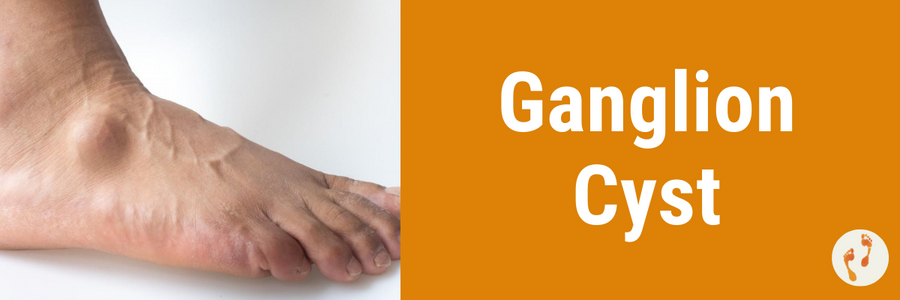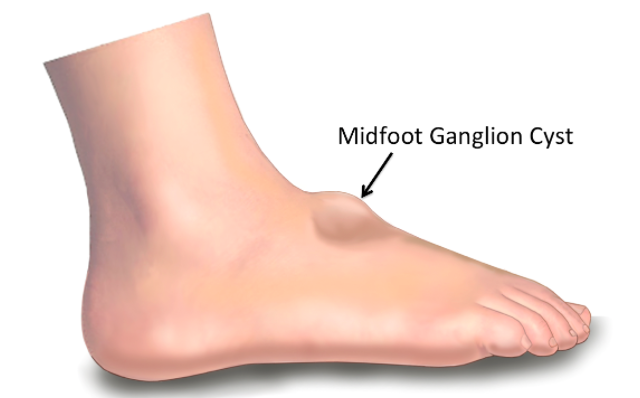 A ganglion cyst is the most common cause of an unexpected, distinctly visible, and in many cases asymptomatic lump on the foot or ankle that our podiatrists see.
A ganglion cyst is the most common cause of an unexpected, distinctly visible, and in many cases asymptomatic lump on the foot or ankle that our podiatrists see.
A ganglion cyst is a smooth, fluid-filled mass that can develop beneath the skin on the feet, as well as the hands and wrists. While the term ‘ganglion’ may initially leave the impression that these cysts are serious or potentially harmful, the cysts themselves are benign (non-cancerous), and their name simply traces back to the Greek term for ‘knot’, or ‘swelling beneath the skin’.
The cause of a ganglion cyst currently remains unknown. It is thought that it may be related to injury, irritation or stress to the foot or ankle, which may result in synovial fluid leaking from a joint and collecting in a sac beneath the skin.
The symptoms of a ganglion cyst can include:
 Noticeable, round lumps that feel jelly-like when pressed upon
Noticeable, round lumps that feel jelly-like when pressed upon- These can be painful or asymptomatic
- The location of the cyst usually determines whether you feel any pain. They are not painful on their own, but they may push against ligaments, tendons or other structures and trigger pain or tenderness.
- If the cyst pushes against a nerve, you may experience tingling, pins and needles, burning or numbness in the area.
- Tight shoes may also press against the cyst and cause irritation or tenderness.
- They often develop near joints, protruding at the top or bottom of the foot.
- They can range in size, but their average size is just below 3cm.
- Ganglion cysts are also unpredictable – appearing spontaneously, increasing in size without a distinct cause, and disappearing and reappearing from time to time.
Can You Fix It?
In many cases, ganglion cysts do not need to be ‘fixed’, particularly if the cyst is not causing you any pain and does not interfere with daily tasks like walking. In this case, you may decide together with your podiatrist to monitor the cyst over time. 58% of cysts have been reported to resolve over time spontaneously, so your podiatrist can offer you reassurance, and teach you any signs to look out for, and what to do if you begin experiencing any discomfort.
Where a ganglion cyst is causing symptoms and you need relief, our podiatrists can help you manage these symptoms so you can move more comfortably.
Podiatrists can first diagnose a ganglion cyst by completing a medical history and injury history, followed by a hands-on assessment of the foot. We look for signs like the cyst moving freely beneath the skin, feeling jelly-like instead of firm, protruding from the skin, and if the cyst appears translucent when a light shines through it. If there are signs of severe pain or inflammation, we will explore other potential causes, too. An ultrasound can be used, if needed, to confirm your diagnosis.
How Is A Ganglion Cyst Treated?
If you and your podiatrist decide that interventions are needed, treatment can fall into two options: non-surgical and surgical.
Footwear advice or modifications
If the cause of your discomfort is coming from your shoes, your podiatrist can discuss with you suitable shoe options that will help prevent this discomfort, or suggest modifications to your existing shoes to make daily life more comfortable for you.
Orthotics
At times, the location of a ganglion cyst on the bottom of the foot can make it difficult to walk comfortably or stay active. In these cases, we may create a pair of custom foot orthotics that have an accommodation for the cyst to allow you to live and move comfortably, even with the cyst present.
Referral for aspiration
In some cases, we may refer you for aspiration where a needle is used to drain the cyst, and may also involve injecting a steroid medication into the mass. The risk here is that the cyst may recur, especially if the cause is related to leaking fluid entering the space as this can simply continue and refill the cyst.
Surgical treatment
In less common cases, if the non-surgical treatment options don’t give you the relief you need, surgical options may be considered. This includes an excision surgery to remove the mass under local anaesthetic. Your podiatrist will discuss these options during your appointment and if needed, refer you to a specialist who can help.
FAQs
Where can a ganglion cyst occur?
We often see ganglion cysts at the top of the foot or near the ankle joint. They can also occur at the front of the knee, as well as in other areas of the body like the hand, wrist and shoulder.
Can a ganglion cyst come back after treatment?
Yes, a ganglion cyst can come back after treatment, even if it is surgically removed. The recurrence rate for ganglion cysts is estimated to be around 5-25%, depending on the location of the cyst and the treatment method used.
Can a ganglion cyst cause long-term complications?
Typically, ganglion cysts are not considered serious and do not cause long-term complications. They are typically benign and do not spread to other areas of the body. However, in some cases, ganglion cysts can cause discomfort or interfere with movement, particularly if they are located near a joint or nerve. If left untreated, a ganglion cyst can also increase in size or cause nearby tissues to weaken or degenerate over time.
